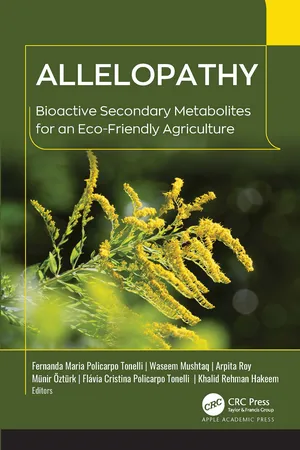
Allelopathy
Bioactive Secondary Metabolites for an Eco-Friendly Agriculture
- English
- ePUB (mobile friendly)
- Available on iOS & Android
Allelopathy
Bioactive Secondary Metabolites for an Eco-Friendly Agriculture
About this book
Allelopathy is a field that can play a major role in containing environmental pollution through providing viable alternatives to synthetic pesticides and contributing to sustainable agriculture. Allelochemicals have the ability to contribute to inhibiting pest damage to crops, to promote weed control, and to help in creating a desirable plant-microbes interaction in soil that improves soil nutrition systems. This new volume provides a brief history of allelopathy and goes on to explore its importance in environmental health and sustainable agriculture, discussing allelopathy from a biotechnological point of view.
A combination of review and research chapters written by experts from around the globe, this volume reviews synthetic pesticides and the environmental pollution associated with them and also looks at allelochemicals as useful bioactive secondary metabolites. It discusses allelopathy induction in crops by natural selection, the main pathways involved in allelochemical production, and plant breeding in allelopathy. The volume also considers the theme of allelopathy and agricultural sustainability, covering plant-based anthelmintic as a new trend to combat helminth infections, the role of microorganisms, the application of allelochemicals against phytopathogens, the role of nanoparticles on fenugreek growth, biotic and salinity stress alleviation in fenugreek, and more. It also reviews genetic engineering approaches to allelopathy. Several chapters discuss the allelopathic potential of specific crops, such as Leucaena leucocephala, Smilax brasiliensis Sprengel (Smilacaceae), and Solanum lycocarpum A. St. -Hil. (Solanaceae).
Offering a valuable overview of allelochemicals as important eco-friendly tools for sustainable agriculture, this volume provides useful information for research scientists, agricultural and botany professionals, as well as faculty and students in the fields of allelopathy, environmental sciences, agriculture, and biotechnology.
Frequently asked questions
- Essential is ideal for learners and professionals who enjoy exploring a wide range of subjects. Access the Essential Library with 800,000+ trusted titles and best-sellers across business, personal growth, and the humanities. Includes unlimited reading time and Standard Read Aloud voice.
- Complete: Perfect for advanced learners and researchers needing full, unrestricted access. Unlock 1.4M+ books across hundreds of subjects, including academic and specialized titles. The Complete Plan also includes advanced features like Premium Read Aloud and Research Assistant.
Please note we cannot support devices running on iOS 13 and Android 7 or earlier. Learn more about using the app.
Information
Table of contents
- Cover Page
- Half Title Page
- Title Page
- Copyright Page
- About the Editors
- Table of Contents
- Contributors
- Preface
- 1. Synthetic Pesticides and Environmental Pollution
- 2. Environmental Health: An Urgent Matter
- 3. Brief History of Allelopathy
- 4. Allelopathy Induction in Crops by Natural Selection
- 5. Crop Allelopathy's Relationship with Herbivory
- 6. Main Pathways Involved in the Production of Allelochemicals
- 7. Plant Breeding in Allelopathy
- 8. Allelopathy and Green Agriculture
- 9. Plant-Based Anthelmintic: A New Trend to Combat Helminth Infections
- 10. The Role of Microorganisms in Allelopathy
- 11. Allelochemicals Against Phytopathogens
- 12. Boost in Allelopathy: A Genetic Engineering Approach
- 13. In Silico Approaches for Green Agriculture
- 14. The Allelopathic Potential of Green Propolis
- 15. Leucaena leucocephala: An Invasive Plant and Source of Allelochemicals in Brazil
- 16. Allelopathic Potential of Smilax brasiliensis Sprengel (Smilacaceae) Species
- 17. Allelopathic Potential of Solanum lycocarpum A. St.-Hil. (Solanaceae) Species
- Index